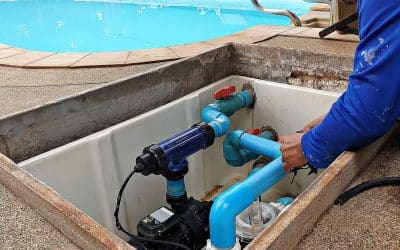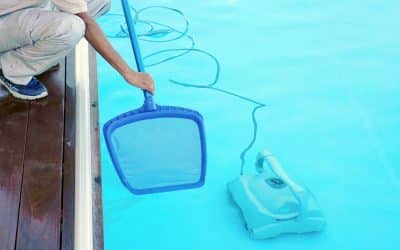By late October in Las Vegas, we start to feel the difference. Hot afternoons can still sneak in, but those cooler desert nights settle fast. That sudden shift is when pool owners start noticing the temperature drop in the water—and start thinking about their heaters. Pool heater repair may not always be front of mind, but it matters more this time of year than people realize.
A working heater keeps your pool comfortable a little longer, even when the air cools off. More than that, it helps protect the rest of your system. When water runs cold through idle equipment for weeks, it adds stress. We want to help pool owners stay ahead of those problems so things don’t pile up during winter or go unnoticed until spring. It’s easier to fix small issues now than deal with system failures later. Timing really does make a difference when it comes to keeping pool equipment running strong in a desert winter.
How Desert Winters Affect Pool Equipment
Living in Las Vegas means dealing with wide temperature swings—warm during the day, cold at night. These shifts can be tough on pool equipment, especially heaters. A heater that runs great all summer can suddenly struggle once the lows dip into the 50s or 40s overnight.
Cold air forces heaters to work harder than usual. It isn’t just about heating the water. Wind and dust from the desert add strain. Air flow gets restricted. Parts dry out or wear down faster. Even strong equipment needs extra care when it runs in harder conditions.
That dry climate means there’s little moisture in the air, and while that might protect against freezing, it can dry out seals and connectors. When pool parts get brittle, leaks and cracks follow. Add in a little sand from the wind and filters clog, heaters overheat, or sensors fail. It’s not always dramatic, but if left alone for too long, those small issues build into something bigger than anyone wants to deal with.
Mojave Pool Company works with gas, propane, and electric pool heater systems in Las Vegas, including full diagnostics to catch wear from wind, dust, and temperature swings.
Spotting Trouble Before it Gets Worse
Most pool heaters don’t quit without dropping a few clues first. One of the most common is longer heat-up time. If the water used to warm up before you finished your coffee and now it takes half the day, that’s a sign. Slow heating usually points to wear inside the unit or something blocking airflow.
Another red flag is sound. Every heater makes some noise when it kicks on, but loud rattling, pops, or high-pitched tones mean something inside might be loose or out of line. Sometimes the unit turns off by itself mid-cycle. That could be a safety shutoff or a misreading in the system—either way, it’s worth checking.
Then there are the silent signs that most people miss. Sensors can give off bad readings, tricking the unit into thinking the water is warmer than it is. Water flow problems inside the heater can confuse the system and shut it down entirely. These aren’t always noticeable until the heater won’t start at all.
Fixing one small thing can often protect other parts too. When a heater strains constantly, it can send extra pressure through the pumps and filters. That pressure wears out other equipment faster. Getting ahead of issues with regular checks or fixing small problems early can keep the whole system healthier over time.
Why Fall Is the Smart Time to Schedule Repairs
There’s a hidden benefit to fixing equipment in late fall. Most people aren’t swimming as often, which means service calls are easier to schedule. You don’t have to rearrange your week or worry about missing pool time.
Repairing gear during cooler weather puts less heat stress on everything. You’re not asking the heater to run full-blast under a blazing sun. That makes it easier to test things out calmly. If parts need to be replaced, it’s safer and less rushed.
This timing helps with peace of mind too. Getting things checked now means spring won’t surprise you with cold water or broken equipment. You flip the system back on, and it just works. That’s the difference between fixing a problem now and discovering a bigger one later when you’re ready to swim again.
When scheduling pool heater repair with Mojave Pool Company in the fall, full inspection includes cleaning ventilation systems and testing controls specific to the pool’s model, helping prevent repeat issues.
How Professional Pool Heater Repair Keeps Things Running Right
Good repair work goes beyond just swapping a part. Anyone can hit a reset button, but knowing what caused the issue in the first place makes the long-term difference. A heater is more than just a box that blows out warmth. Inside, it’s a mix of burners, sensors, wiring, and valves.
When we look at a failing heater, we don’t just check the obvious spots. We take time to inspect things around it too—like water pressure levels, gas lines, and airflow paths. A dusty air vent or loose connection can cause a shutdown just the same as a broken part.
There’s also safety to think about. Pool heaters deal with water, electricity, and gas all at once. That’s a serious mix. Working on them without the right training can cause more damage, or worse, create safety risks that aren’t easy to spot right away.
Getting a complete inspection from someone trained in how these systems connect helps avoid the kind of fixes that might only last a few weeks. We aim to get things working properly, not temporarily.
Keep Your Heater Ready for the Season Ahead
Having a working pool heater in Las Vegas can make pool care easier through the colder months. Even if you’re not swimming every day, running the heater regularly keeps your water moving and your system balanced. Still water in winter can cause buildups, cloudy issues, or extra cleaning when everything restarts.
When heaters go unchecked and miss seasonal servicing, we often see more wear in the spring. By then, the damage isn’t just to the heater—it can touch the pump and filter too. Taking care of repair needs early means avoiding that stress altogether.
Pool season might slow down, but it doesn’t end completely here. The sun’s still strong, and it’s not unusual to dip into a warm pool in November or even December. Keeping the heater running right helps keep that option open. More important, it protects everything behind the scenes so your pool’s ready again when the warmer days return.
Cooler nights are creeping in, and if your pool heater isn’t keeping up, this is the time to get it checked. With shifting Las Vegas weather, catching issues early can save you bigger headaches later. A quick tune-up or small repair now helps avoid surprises when you’re ready to swim again. If you’re not sure where to begin, our pool heater repair service covers everything from diagnosis to fix. Mojave Pool Company is ready to help you keep your system running right.




